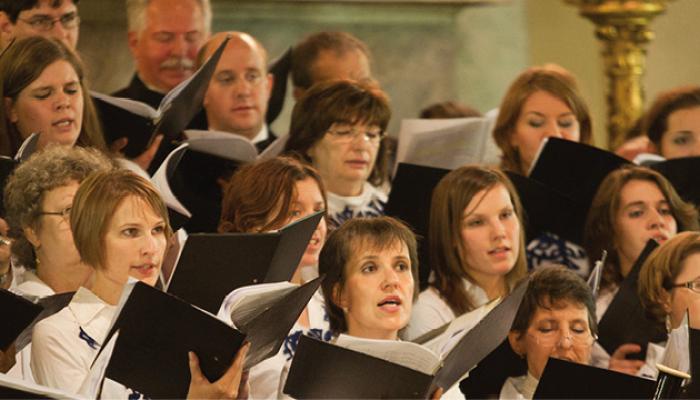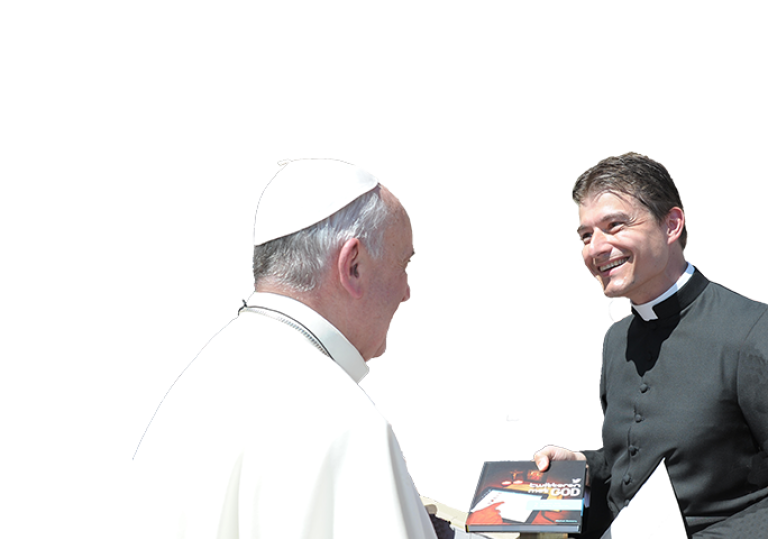
3.47 Who chooses the readings? Am I allowed to sleep during the homily?
The Church has drawn up a timetable for the readings, so that church-goers can hear as many different Bible texts as possible during the year. Every day or feast-day has specific readings assigned to it.
In the homily, the priest explains and explores the meaning of the readings. Often a link is made with our daily lives. One homily may touch you more than another, but you can always get something out of it. After all, it is about Jesus who is inviting you to follow him and become truly happy! The #TwGOD app can help you to follow the standard texts of the Mass in many languages.
How is the celebration of the Holy Eucharist carried out?
The Eucharist unfolds in two great parts which together form one, single act of worship. The Liturgy of the Word involves proclaiming and listening to the Word of God. The Liturgy of the Eucharist includes the presentation of the bread and wine, the prayer or the anaphora containing the words of consecration, and communion. [CCCC 277]
What elements are essential to a Holy Mass?
Every Holy Mass (celebration of the Eucharist) unfolds in two main parts, the Liturgy of the word and the Liturgy of the Eucharist.
In the liturgy of the Word, we hear readings from the Old and New Testament and also the Gospel. Besides that there is an opportunity for preaching and general intercessory prayers. In the subsequent Liturgy of the Eucharist, bread and wine are offered, consecrated and distributed to the faithful at Communion. [Youcat 213]
How is the Mass structured?
Holy Mass begins with the gathering of the faithful and the entrance of the priest and the others who serve in the sanctuary (altar servers, lectors, cantors, and so on). After the greeting comes the Penitential Rite, which concludes with the Kyrie. On Sundays (outside of Advent and Lent) and feast days, the Gloria is then sung or recited. The prayer of the day introduces one or two readings from the Old and New Testament, followed by the responsorial psalm. Before the Gospel is read, there is an Alleluia, or acclamation. After the proclamation of the Gospel on Sundays and feast days, the priest or deacon gives a homily at least on Sundays and feast days. Then, again only on Sundays and feast days, the congregation professes its common faith in the Creed, followed by the intercessions. The second part of Holy Mass begins with the preparation of the gifts, which concludes with the Offertory prayer. The high point of the Eucharistic celebration is the Eucharistic Prayer, which is introduced by the Preface and the Sanctus. Now the gifts of bread and wine are transformed into the Body and Blood of Christ. The Eucharistic Prayer concludes, finally, in the doxology, which makes the transition to the Lord’s Prayer. Then comes the prayer for peace, the Agnus Dei, the breaking of the bread, and the distribution of the holy Gifts to the faithful, which often is done only under the form of the Body of Christ. Holy Mass ends with meditation, thanksgiving, a concluding prayer, and a blessing by the priest.
The Kyrie
Celebrant. Lord, have mercy!
Response. Lord, have mercy!
C. Christ, have mercy!
R. Christ, have mercy!
C. Lord, have mercy!
R. Lord, have mercy!
C. Kyrie eleison! R. Kyrie eleison!
C. Christe eleison! R. Christe eleison!
C. Kyrie eleison! R. Kyrie eleison!
The Gloria
Glory to God in the highest,
and on earth peace to people of good will.
We praise you, we bless you,
we adore you, we glorify you,
we give you thanks for your great glory,
Lord God, heavenly King,
O God, almighty Father.
Lord Jesus Christ, Only Begotten Son,
Lord God, Lamb of God, Son of the Father,
you take away the sins of the world,
have mercy on us;
you take away the sins of the world,
receive our prayer;
you are seated at the right hand of the Father,
have mercy on us.
For you alone are the Holy One,
you alone are the Lord,
you alone are the Most High,
Jesus Christ,
with the Holy Spirit,
in the glory of God the Father.
Gloria in excelsis Deo
et in terra pax hominibus bonae voluntatis.
Laudamus te, benedicimus te,
adoramus te, glorificamus te,
gratias agimus tibi propter magnam gloriam tuam,
Domine Deus, Rex caelestis,
Deus Pater omnipotens,
Domine Fili unigenite, Iesu Christe,
Domine Deus, Agnus Dei,
Filius Patris,
qui tollis peccata mundi, miserere nobis;
qui tollis peccata mundi,
suscipe deprecationem nostram.
Qui sedes ad dexteram Patris, miserere nobis.
Quoniam tu solus Sanctus,
tu solus Dominus,
tu solus Altissimus, Iesu Christe,
cum Sancto Spiritu:
in gloria Dei Patris. Amen.
The Sanctus
Holy, Holy, Holy Lord God of hosts.
Heaven and earth are full of your glory.
Hosanna in the highest.
Blessed is he who comes in the name of the Lord.
Hosanna in the highest.
Sanctus, Sanctus, Sanctus Dominus Deus Sabaoth.
Pleni sunt caeli et terra gloria tua.
Hosanna in excelsis.
Benedictus qui venit in nomine Domini.
Hosanna in excelsis.
The Agnus Dei
Lamb of God, you take away the sins of the world, have mercy on us.
Lamb of God, you take away the sins of the world, have mercy on us.
Lamb of God, you take away the sins of the world, grant us peace.
Agnus Dei, qui tollis peccata mundi, miserere nobis.
Agnus Dei, qui tollis peccata mundi, miserere nobis.
Agnus Dei, qui tollis peccata mundi, dona nobis pacem.
[Youcat 214]
Proclaim the Word at every opportune and inopportune occasion. Admonish, rebuke, but always with kindness; exhort unfailing in patience and teaching. May your words be simple, that all may understand, may they not be long homilies. Allow me to say to you: remember your father, when he was so happy to have found another parish near your home town, where Mass was celebrated without a homily! Homilies are truly the conveyance of God’s grace: simple, so that all may understand and want to improve themselves. [Pope Francis, Homily, 9 Nov. 2015]





